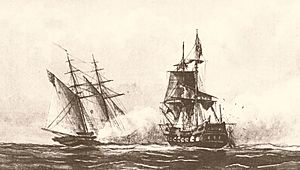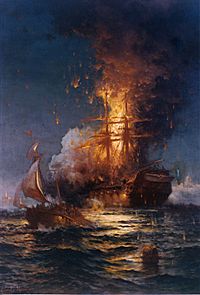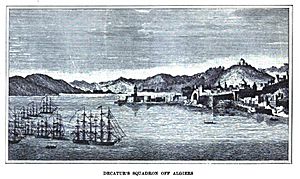Mediterranean Squadron (United States) facts for kids
Quick facts for kids Mediterranean Squadron |
|
|---|---|

USS Enterprise of the Mediterranean Squadron capturing the polacca Tripoli during the First Barbary War.
|
|
| Active | 1801–1865 |
| Country | |
| Branch | |
| Type | Naval squadron |
| Garrison/HQ | Mahón (1815–1840) |
The Mediterranean Squadron was a group of ships from the United States Navy. It sailed in the Mediterranean Sea during the 1800s. This squadron was created to protect American merchant ships. It was especially important during the First Barbary War and the Second Barbary War.
From 1801 to 1818, different groups of ships took turns serving in the squadron. Later, from the 1820s to the 1860s, the squadron helped stop piracy, especially near Greece. They also used "gunboat diplomacy," which means showing military strength to solve problems without fighting. In 1865, the squadron changed its name to the European Squadron.
Contents
History of the Squadron
Fighting the Barbary Pirates
After the American War of Independence in 1783, Barbary pirates started attacking American merchant ships. These pirates were from North African states like Algiers. The ruler of Algiers, called the Dey, demanded money (tribute) from the United States. When the Americans refused, it led to many conflicts from the 1780s to 1815. The Mediterranean Squadron was formed to keep American ships safe.
The first group of ships was led by Commodore Richard Dale. His ships included the large frigates USS Boston, USS Essex, USS Philadelphia, and USS President. There was also the smaller USS George Washington and the schooner USS Enterprise. From 1801 to 1802, this squadron helped protect merchant ships by sailing with them in convoys.
Commodore Dale's orders were limited. He could only fight back if his ships were attacked first. On August 1, 1801, the USS Enterprise (a schooner) met a Tripolitan ship called Tripoli. The Enterprise captured the Tripoli after a tough fight. However, because of the rules, they couldn't keep the ship. So, they removed its weapons and let it go.
The pirate attacks continued. So, the U.S. government allowed the Navy to send another squadron. This group was ordered to blockade Tripoli and attack enemy ships. In May 1802, Captain Daniel McNeill on USS Boston helped two Swedish frigates. They fought off several Barbary ships trying to leave Tripoli harbor.
In June 1803, USS John Adams and USS Enterprise defeated nine enemy gunboats and another ship near Tripoli. The enemy ship sank, and the gunboats fled. The Americans had no injuries. This second squadron returned home in 1803.
Later that year, a new force was sent. On October 31, 1803, the USS Philadelphia got stuck on a reef near Tripoli Harbor. Under heavy fire from shore, the crew tried to free the ship, but it was stuck fast. When Tripolitan gunboats came to capture it, the American commander surrendered. He and his crew were taken as prisoners. The Tripolitans then used the Philadelphia for their own defense.
On February 16, 1804, Lieutenant Stephen Decatur led a daring mission. He and his crew on the small ship USS Intrepid boarded the captured Philadelphia. They recaptured it and then set it on fire so the enemy couldn't use it again. This brave act made Decatur famous. He continued to serve the Navy with honor and later led American forces in the Second Barbary War.
The First Barbary War ended with the Battle of Derne in April and May 1805. Ships from the Mediterranean Squadron, like the brig USS Argus, the schooner USS Nautilus, and the sloop USS Hornet, helped. They fired their guns to support American marines and soldiers who were attacking the city of Derne. When the city fell, the ruler of Algiers surrendered, ending the war.
The Second Barbary War
The Mediterranean Squadron stayed in operation until 1807. Then, the ships were called back home. This gave the Barbary pirates a chance to attack American ships again. The United States Navy did not return to the Barbary Coast until 1815, after the War of 1812 ended.
By then, Stephen Decatur was a commodore. He led the main squadron of ten ships. This included large frigates like USS Guerriere, USS Macedonian, and USS Constellation. There were also smaller ships like sloops, brigs, and schooners. Another group of ships, led by Commodore William Bainbridge, also sailed to the area.
Only two main battles happened during the Second Barbary War. On June 15, Decatur's squadron captured the Algerian flagship Mashouda near Cape Gata. A few days later, on June 19, they defeated another ship called Estedio near Cape Palos. After these victories, the squadron arrived at Algiers. Before more fighting could start, the enemy surrendered, and the short war ended.
Images for kids
-
USS Enterprise of the Mediterranean Squadron capturing the polacca Tripoli during the First Barbary War.






